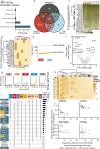A spatio-temporal brain miRNA expression atlas identifies sex-independent age-related microglial driven miR-155-5p increase
- PMID: 40382330
- PMCID: PMC12085673
- DOI: 10.1038/s41467-025-59860-6
A spatio-temporal brain miRNA expression atlas identifies sex-independent age-related microglial driven miR-155-5p increase
Abstract
An in-depth understanding of the molecular processes composing aging is crucial to develop therapeutic approaches that decrease aging as a key risk factor for cognitive decline. Herein, we present a spatio-temporal brain atlas (15 different regions) of microRNA expression across the mouse lifespan (7 time points) and two aging interventions. MicroRNAs are promising therapeutic targets, as they silence genes by complementary base-pair binding of messenger RNAs and mediate aging speed. We first established sex- and brain-region-specific microRNA expression patterns in young adult samples. Then we focused on sex-dependent and independent brain-region-specific microRNA expression changes during aging. We identified three sex-independent brain aging microRNAs (miR-146a-5p, miR-155-5p, and miR-5100). For miR-155-5p, we showed that these expression changes are driven by aging microglia and target mTOR signaling pathway components and other cellular communication pathways. In this work, we identify strong sex-brain-region-specific aging microRNAs and microglial miR-155-5p as a promising therapeutic target.
© 2025. The Author(s).
Conflict of interest statement
Competing interests: The authors declare no competing interests.
Figures





Update of
-
A spatio-temporal brain miRNA expression atlas identifies sex-independent age-related microglial driven miR-155-5p increase.bioRxiv [Preprint]. 2025 Mar 16:2025.03.15.643430. doi: 10.1101/2025.03.15.643430. bioRxiv. 2025. Update in: Nat Commun. 2025 May 17;16(1):4588. doi: 10.1038/s41467-025-59860-6. PMID: 40161726 Free PMC article. Updated. Preprint.
References
-
- Lopez-Otin, C., Blasco, M. A., Partridge, L., Serrano, M. & Kroemer, G. Hallmarks of aging: An expanding universe. Cell186, 243–278 (2023). - PubMed
MeSH terms
Substances
Grants and funding
LinkOut - more resources
Full Text Sources
Medical
Molecular Biology Databases
Miscellaneous

